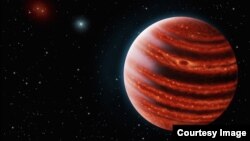Astronomers have taken a photograph of a baby planet beyond the solar system that may reveal clues about how planets such as Jupiter are formed and influence their planetary siblings, a study released Thursday shows.
Scientists used the newly commissioned Gemini Planet Imager, which is mounted on top of a telescope in Chile, to find the planet, known as 51 Eridani b. It circles a very young, sunlike star that is located about 96 light-years from Earth.
The planet, which is about double the size of Jupiter, is positioned a bit farther away from its parent star than Saturn is from our sun. 51 Eridani b is one of the smallest planets beyond the solar system to be directly imaged.
Still radiating heat from its formation less than 20 million years ago, or about 40 million years after dinosaurs became extinct, 51 Eridani b is glowing in infrared light, which is how the telescope saw it.
"51 Eri b provides an opportunity to study in detail a planet that is still influenced by its formation initial conditions," Stanford University astronomer Bruce Macintosh and colleagues wrote in this week's issue of the journal Science.
Follow-up analysis revealed that the planet's atmosphere, like Jupiter's, is dominated by methane. The discovery provides an important clue for scientists trying to figure out how these types of gas-giant planets form and evolve.
"51 Eri b is the first young planet that probably looks like Jupiter did billions of years ago, making it currently our most important cornerpiece of the planet-formation jigsaw puzzle," University of Arizona planetary scientist Travis Barman said in a statement.
Astronomers have been able to directly see only a handful of planets beyond the solar system, and nearly all of those have been five to 13 times as massive as Jupiter.
Other telescopes, like NASA's Kepler observatory, look for planets indirectly. Kepler, for example, looked for slight dips in the amount of light coming from target stars, a possible clue that an orbiting planet was crossing the face of its parent star.
Another method is to look for wobbles in starlight that may be caused by the slight gravitational tugs of circling planets.













